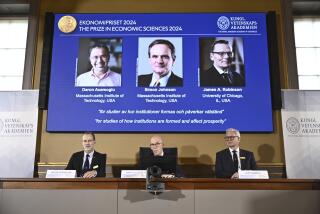Do You Want an Economist Teaching Your Kid This Stuff ?
- Share via
The nation’s high school students have been getting some well-deserved black eyes. They are a sorry bunch indeed. If it isn’t dope, it’s steroids. They can’t do algebra or push-ups. A lot of them apparently don’t know where the ocean is.
But it is time someone rose to their defense for five or 10 seconds. The recent news that more than half flunked an “economic literacy” test had a cheerful ring to it.
I salute anyone whose eyes glaze over at the words “opportunity cost,” which came up three times in the test. And he who hesitates at the dictum that both countries gain when U.S. wheat is traded for Saudi oil deserves an A, not an F.
Pistachios, sure. Oil, it depends. But that is the sort of complication that economists cannot abide because it gums up their equations. This test calls for a tirade against economists, not teen-agers.
Results of the test, taken by more than 8,000 high school seniors, were trumpeted last month by the Joint Council for Economic Education as part of a campaign it is conducting in broad daylight to make more people study economics.
The council calls the results “astounding”: The dimwits answered only 40% of the multiple-choice questions right. Random guesses, the economists noted, would have produced a 25% score.
Apparently looking for an economist someone would believe, the group enlisted former Federal Reserve Chairman Paul A. Volcker to urge that we start teaching economics in the first grade.
But I don’t know what good that would do. The high school kids who had studied economics scarcely outperformed those who hadn’t. High school economics teachers who have taken the test, confides one of its authors, averaged 55% to 60%.
Irwin Stelzer of Harvard, an economist who had nothing whatsoever to do with this economic literacy test, recalls a true-false economics quiz administered to college students years ago. He says they got the same score on the last day of class as they did on the first.
Obviously, something is going on here besides a dearth of economics courses. I think it is economist illiteracy.
Of the nation’s 177,000 economists, it is believed that only 25 or 50 think clearly. Stelzer is among them. He says one problem is that economists themselves are confused. They are passing this confusion along to their students.
That explains something about this test that economists would appreciate: There is an oversupply of correct answers. As happens when there is an oversupply of something, it isn’t worth much.
Question 16: The price of shoes is likely to be increased by (a) new machines reducing the cost of shoe production (b) more capital investment by producers (c) a decrease in the demand for shoes (d) a decrease in the supply of shoes.
According to the Joint Council on Economic Education, the right answer is (d). That is obviously one right answer, but arguably so are (a) and (b).
A Foreign Language?
The economists would argue that the shoe manufacturer is not supposed to raise prices merely to pay for the new $1-million machine that is going to cut his cost of making shoes. But he will anyway. Where I come from, the price of shoes is likely to be increased, period.
Sometimes, there are two or three “right” answers that all miss the point. Why do ballplayers make more than farmers? The authorized answer is (d) good ballplayers are more scarce, given the demand for their services. But (c), which simply points out there are fewer ballplayers, works fine.
Of course, neither gets to the root of it, which is that hardly anybody would pay to watch a farmer farm. But I guess that’s not economics.
The test is riddled with economic jargon, including the aforementioned “opportunity cost.” This is a piece of mumbo jumbo that refers to life’s little financial trade-offs, such as the wages we don’t earn while going to college.
The test asks about “aggregate demand” instead of calling it the demand for all goods and services, which is obscure enough. It refers to raising the “discount rate” instead of raising interest rates.
It uses “margin requirement” instead of the amount of cash an investor must put up to buy stocks on credit.
William B. Walstad, a friendly economics professor at the University of Nebraska, helped write the test and stoutly defends it. All sciences have jargon, he says, and “we call economics a science. There is a Nobel prize in economic science. This is a test of students’ exposure to basic economics.”
Well, it is a test of exposure to economic jargon. It has the unmistakable smell of economists talking to economists. Stelzer says sternly: “There is no jargon that cannot be replaced with good English.”
The fact that most grown-ups don’t understand the economists may be one reason this country is still standing. I say the answer to economic illiteracy is to get our economists speaking English, not stand by while they take the teen-agers down with them.
Meanwhile, says Stelzer, “The best way to test a kid’s exposure to basic economics is to put him outside on a sunny day to sell strawberries and see if he knows enough to lower his prices when they start to rot.”
More to Read
Get the L.A. Times Politics newsletter
Deeply reported insights into legislation, politics and policy from Sacramento, Washington and beyond. In your inbox three times per week.
You may occasionally receive promotional content from the Los Angeles Times.










